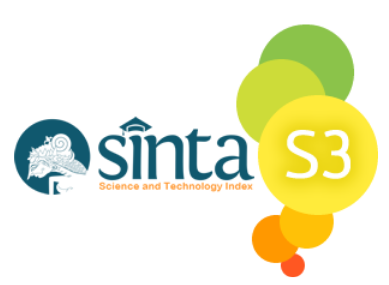CHARLES SANDER PEIRCE SEMIOTICS IN ORAL LITERATURE “KABATA KORA-KORA” IN BANDA NEIRA
Abstract
Oral literature is a type of literary work that is passed down by word of mouth which is likely to change from generation to generation, either in grammar, certain plot, etc, because this work is transmitted from generation to generation through oral, it is not known for sure who who has produced or created the work. Folk song or also called Kabata by Banda people is a form of singing that uses the local language namely Tana language or can be said as traditional song. Not many people can understand the meaning of Kabata, Kabata now is only understood by traditional elders. Kabata is usually sung or heard when a traditional ceremony is held. One of the regional literatures in traditional ceremonies that will be the focus of this study is Kabata kora-kora. This qualitative descriptive study was conducted in Kampung Baru village, Banda sub-district, Central Maluku district, by involving traditional elders as resource persons. Data collection technique was carried out by interview. The result of this analysis is there are 13 sentences in kabata kora-kora in Kampung Baru (Fiat) village, each of them is chanted one by one according to the place where this kabata is used in their journey of rowing the kora-kora. In Kabata kora-kora in Kampung Fiat that was grouped based on Charles Sanders Peirce's theory, there are 1 icon, 8 indexes and 4 symbols. 3 of the 9 indexes are space indexes and 4 of them are persona indexes.
Keywords
Full Text:
PDFReferences
Darman, F. (2014). Struktur dan Nilai Patriotisme dalam Legenda Dramatis Jejak Para Satria di Negeri Seribu Bukit, Morella. In Mariana (Ed.), Prosiding Bahasa dan Sastra Melukis Harmoni (pp. 131—153). Ambon: HISKI Komisariat Ambon.
Marihandono, D. (2015). Memanfaatkan Karya Sastra Sebagai Sumber Sejarah. In Stella Rose (Ed.), Prosiding Sastra dan Solidaritas Bangsa (pp. 81—91). Ambon: Kantor Bahasa Maluku.
Danesi Marcel. 2010. Pesan Tanda dan Makna. Jalasutra : Yogyakarta
Zoest, van Aart. 1993. Semiotika: Tentang Tanda, Cara Kerjanya, dan Apa yang Dilakukan Dengannya. Jakarta: Sumber Agung.
Yohanes Sehandi 2014, Mengenal 25 Teori sastra. Yogyakarta: Ombak
Latuperissa, Nelson A. 2011. Makna Nyanyian Rakyat di Maluku: Kajian semiotikaHenaMasa,(online),http://fmmindonesia.webs.com/documents/Nelsano Kapata.pdf.
Mailoa, Piet Jan. 2006. Kamus Bahasa-Harian Dialek orang Ambon. Jakarta: Kulibia Printing.
Lelapary, Heppy Leunard. 2010. Karakteristik Tradisi Kapata di Maluku Tengah Kajian Etnografi. Disertasi. Tidak Diterbitkan. Malang: PPS Universitas Negeri Malang.
Zuldafrial.2012.Penelitian kualitatif. Surakarta : Yuma Pustaka.
Sugiyono.2009.Metode Penelitian Pendekatan Kuantitatif, Kualitatif dan R&D. Bandung: Alfabeta .
Sugiyono. 2014. Metode Penelitian Kuantitatif Kualitatif dan R&D. Bandung: Alfabeta.
Miles, B. Mathew dan Michael Huberman. 1992. Analisis Data Kualitatif Buku Sumber Tentang Metode-metode Baru. Jakarta: UIP
DOI: https://doi.org/10.18551/erudio.8-2.4
Refbacks
- There are currently no refbacks.
Copyright (c) 2021 Erudio Journal of Educational Innovation

This work is licensed under a Creative Commons Attribution 4.0 International License.












